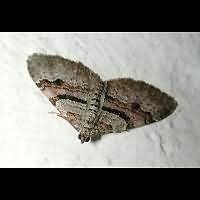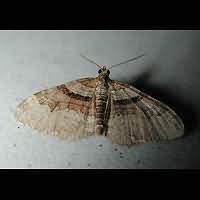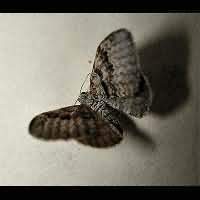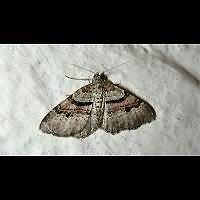Flame Carpet (Xanthorhoe designata)
The Flame Carpet is a very variable species, even though the basic lay out remains the same in all specimens. It is a greyish or browngreyish moth. The upper wings show small often brown red shoulders (= the beginning of the front wings). This is followed by a greyish white band. Next is a dark brown band, followed by a dark red one. This red one often has two small dark brown bands running over it. The remainder of the front wing is greyish white. On the border of the red and white is a small dark band often with a striking black dot. The red often is very weak and sometimes hardly visible. The black dots may be missing and one or more bands may be wissing as well, or don't run all over the wing. Despite all these variations this species is easily identified most of the times. The animal is quite small, for the wingspan is some 25 to 28 mm only.
The Flame Carpet is double-brooded in most of Britain. After having been overwintering as a pupa, the first generation of moths appears in May. The larvae of this generation we'll see in June and July. The larvae are clearly two-coloured: the upper half of the body is greyish brown, dark brown or reddish brown, the lower part of the body is greyish white. The two colours make a sharp contrast at the side of the caterpillar. On top the larva has a rather remarkable marking repeated a few times: an open and more or less complete white caret, followed by a black dot. The caterpillars pupate in July, giving way to the second generation in August. Not much is known about the host plants of the larvae in the wild. It is suspected though they'll eat crucifers, for in captivity they accept cabbage, rape and wallflower.
This species is flying about from May to September all over the British Isles. In bad summers the North of Scotland will see just one generation flying in June and July mainly. It is attracted to light but in small numbers only. Apparently has no favourable habitat: appears in moorlands, forests and gardens alike. Still not a very common species, even though at certain locations very common indeed. Inhabits all of the British Isles, including the Inner Hebrides, but is rare on the Channel Islands. On the continent een wide spread, but often local species too. In Northern Europe the Flame Carpet produces just one generation, but three or more in the south of Europe.
The Flame Carpet is a very variable species, even though the basic lay out remains the same in all specimens. It is a greyish or browngreyish moth. The upper wings show small often brown red shoulders (= the beginning of the front wings). This is followed by a greyish white band. Next is a dark brown band, followed by a dark red one. This red one often has two small dark brown bands running over it. The remainder of the front wing is greyish white. On the border of the red and white is a small dark band often with a striking black dot. The red often is very weak and sometimes hardly visible. The black dots may be missing and one or more bands may be wissing as well, or don't run all over the wing. Despite all these variations this species is easily identified most of the times. The animal is quite small, for the wingspan is some 25 to 28 mm only.
The Flame Carpet is double-brooded in most of Britain. After having been overwintering as a pupa, the first generation of moths appears in May. The larvae of this generation we'll see in June and July. The larvae are clearly two-coloured: the upper half of the body is greyish brown, dark brown or reddish brown, the lower part of the body is greyish white. The two colours make a sharp contrast at the side of the caterpillar. On top the larva has a rather remarkable marking repeated a few times: an open and more or less complete white caret, followed by a black dot. The caterpillars pupate in July, giving way to the second generation in August. Not much is known about the host plants of the larvae in the wild. It is suspected though they'll eat crucifers, for in captivity they accept cabbage, rape and wallflower.
This species is flying about from May to September all over the British Isles. In bad summers the North of Scotland will see just one generation flying in June and July mainly. It is attracted to light but in small numbers only. Apparently has no favourable habitat: appears in moorlands, forests and gardens alike. Still not a very common species, even though at certain locations very common indeed. Inhabits all of the British Isles, including the Inner Hebrides, but is rare on the Channel Islands. On the continent een wide spread, but often local species too. In Northern Europe the Flame Carpet produces just one generation, but three or more in the south of Europe.







